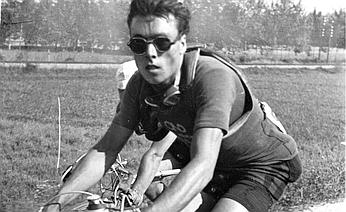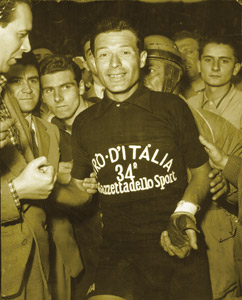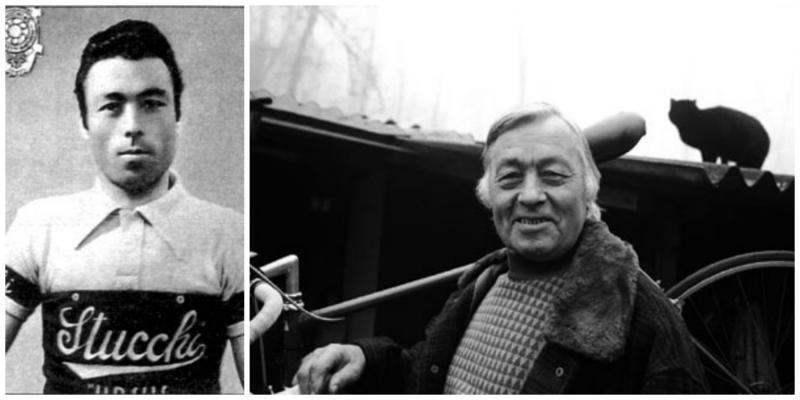Giuseppe di Cozzelli isn’t a household name. In 1926, Giuseppe would go on to ride his first and last edition of il Giro d’Italia completing only three stages. His contribution led to the birth of an enigmatic cycling hero, and a colour shirt that was anything but rosa; la Maglia Nera. (The Black Jersey)
 In 1946 Italy was experiencing a radical change. The post-war government was enacting a new constitution, “Italy is a nation built on work” its first article. This hard working and newly appointed meritocratic system became a championing ethos spreading around the nation; Cycling became the metaphor that captured a country’s spirit.
In 1946 Italy was experiencing a radical change. The post-war government was enacting a new constitution, “Italy is a nation built on work” its first article. This hard working and newly appointed meritocratic system became a championing ethos spreading around the nation; Cycling became the metaphor that captured a country’s spirit.
Gripped by the rivalry between the nation’s two favourite sons, Bartali and Coppi, Italy’s metaphor was clear for everyone to see, if you were willing to work hard, success of any kind would put food on the table to feed you and your family. This wasn’t only a case for the winners, but even the greatest of losers.
The 1946 edition of the Giro D’Italia was Luigi Malabrocca’s first. A young competitor with an exceptional ability, he would capture the minds of those passionate about cycling, but who embodied the “new” attitude to Italy’s belief, he worked hard, at losing. He would go on to place last in the general classification, nearly four hours after race winner Gino Bartali. The Giro organisers that year awarded the first Maglia Nera since di Cozzelli bore its birth in 1926. Italians had a new hero, albeit in an unorthodox manner.
Coming last had its advantages; prize money would be given by villagers as well as a free room for the evening along with food and drink as an act of solidarity towards the rider. When Malabrocca returned in 1947 he had acquired a fan base, people on the streets would hold banners “long live last place” as well asking “who’s first?” swiftly followed by “who is last?” Unsurprisingly, Malabrocca would finish last, again. His time nearly six hours after his friend and training partner, Fausto Coppi had won the general classification.
If Bartali had Coppi, Malabrocca had Carolo.
The 1949 edition of the Giro may be best remembered for the famous mountain victory by Fausto Coppi at the Cuneo-Pinerolo stage, but for the Giro fans at the time, tongues would wag about the rivalry between Malabrocca and Carolo, each determined to finish last.
Sante Carolo was a builder by profession, a cyclist by passion. In a last minute call, he was asked to replace Fiorenzo Magni who had gone down with a stomach infection and couldn’t compete. As fate would have it though, Carolo was not a good cyclist, if anything, his lack of skill and speed was due to being a poor athlete. However, knowing this, Carolo realised that he couldn’t compete with the other riders and instead focused his attention on winning the prestigious Maglia Nera.
Stories of cycling procrastination would be hard to match if you could try. Stopping for leisurely lunches and hiding was a common tactic used by both riders; Malabrocca taking it to levels like no other. On one stage he decided to hide in a farmer’s water tank, when questioned on what he was doing, Malabrocca replied “riding the giro”, the farmer, astonished, remarked “in my water tank?”
The rivalry had intensified as the winner of the black jersey was changing hands frequently. Everything was playing into the hands of Malabrocca, whose tricks had given him a huge advantage leading into the final stage, la Maglia Nera would be his for the third time. To the amazement of many, Malabrocca started the final day quickly. He claimed a cash prize for coming first in one of the four chronometer events, after which he literally disappeared. The race continued, Malabrocca was still nowhere to be seen. His detour landed him in a bar, where he was treated to food and drink, a local villager offering to show him his fishing gear, which Malabrocca duly obliged to view, he wasn’t in a rush.
To the amazement of many, Malabrocca started the final day quickly. He claimed a cash prize for coming first in one of the four chronometer events, after which he literally disappeared. The race continued, Malabrocca was still nowhere to be seen. His detour landed him in a bar, where he was treated to food and drink, a local villager offering to show him his fishing gear, which Malabrocca duly obliged to view, he wasn’t in a rush.
The Giro would be won by Fausto Coppi, Bartali a close second. However, it would be Sante Carolo, and not Malabrocca who would claim the coveted Maglia Nera.
In a twist of cruel fate, Malabrocca did nothing wrong. The tactic to delay his finish within the regulations had worked; arriving over two and half hours after the stage winner, Malabrocca naturally thought he had done enough to secure his hat trick of last places in the Giro. The course judges however had enough. Fed up of all the drama, and theatrics, they packed up and left. They would give Malabrocca the peloton race time, making his overall average race classification penultimate place.
Luigi Malabrocca would leave road cycling after the 1949 giro. In his own right he would become a world cyclo-cross champion, twice. La Maglia Nera, however, would be abolished in 1951. Protests came from other riders, feeling that their achievements were being ridiculed, whilst fans became less interested and patient as well.
La Maglia Nera, however, would be abolished in 1951. Protests came from other riders, feeling that their achievements were being ridiculed, whilst fans became less interested and patient as well.
But Malabrocca had a left a lasting legacy, the Giro needed a cult hero, and Malabrocca was the man to fill those shoes. Malabrocca passed away in 2006, writing in La Gazzetta Dello Sport, Marco Pastonesi said of the rider; “Luigi Malabrocca was a unique figure in Italian cycling history, a special man who wrote the end of an era, of a romance, a history, of a different cycling time. Men like Malabrocca die, but they never leave us.”













